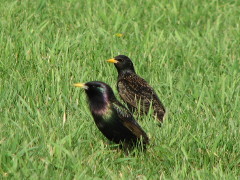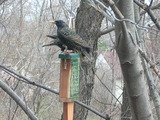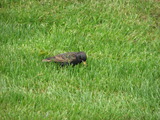Lifebird #22 - Blame it on the Bard

The European Starling is one of three species we birders love to hate. American birders, at least. “Hate” is probably too strong a word, but why do we dislike starlings at all? It’s not looks: their bright yellow bills and legs contrast nicely with their plumage is glossy black with iridescent brown and greenish-yellow spots. Their calls are mostly unattractive squeaks and whistles, but they are talented mimics. It is the starlings’ success we dislike.
European Starlings were introduced by Shakespeare enthusiasts to New York City’s Central Park in the 1890s. They have succeeded wildly, and descendants of these released birds can now be found across the United States and Canada, and in parts of Mexico. I’ve seen them in Minnesota, California, Alaska, Virginia, Louisiana, and a few other states. Which is to say, anywhere I’ve looked. (I’ve also found them in London, England, which is one place where they ought to be.) The problem with this success is that these birds are very aggressive and out-compete other cavity-nesting songbirds. They have contributed to declines in the populations of some of our native species.
Read my thoughts on Lyanda Lynn Haupt’s Mozart’s Starling.
The first European Starling I saw was probably out-competing a woodpecker for the suet in one of my feeders. I see them occasionally in our yard, but not regularly (this was true in Little Canada, and it’s true of our yard in Shoreview as well). I consider myself lucky in this respect, because starlings tend to gather in large flocks, and might easily overrun my feeders if they spent more time in the neighborhood.
| Species | European Starling / Sturnus vulgaris |
| Where | Home, Little Canada, MN |
| When | November 2003 |
| With | Joann |
| Number | 22 |
See lifebird index.


